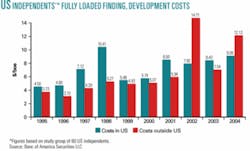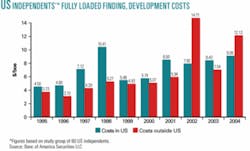The aggregate fully loaded finding and development (F&D) cost for a study group of 12 major integrated international oil companies and 60 US independent companies increased considerably in 2004 over 2003, reported Banc of America Securities (BAS) in a report released April 18 (see Fig.). Responsible for these increases, BAS said, was a sharp escalation in acquisition and service costs, coupled with fewer added reserves and net negative reserve revisions.
The integrated companies’ fully loaded F&D cost rose to an all-time high of $9.55/boe in 2004 from $7/boe in 2003, a jump “primarily driven by a 50% drop in proven reserves added per successful well in the US and net negative reserve revisions,” BAS reported. The group’s 10-year average is $5.15/boe.
The integrateds’ 2004 F&D cost is slightly below the aggregate $9.65/boe all-time high of the independents, which experienced a 20% increase over their aggregate $7.95/boe 2003 posting (see Table).
“This was the first time in the last 10 years that the integrateds posted net negative reserve revisions, which contributed to the narrower finding cost gap between the two groups,” BAS noted.
The study showed the integrateds’ exploration and development (E&D) costs (excluding revisions) to be $9.85/boe, just above the independents’ $9.70/boe figure, “driven largely by an uptick in the integrateds’ US costs,” the report noted. “In fact, the integrateds’ domestic E&D costs (excluding revisions) were $16.80/boe, or roughly 70% higher than the independents.”
Although the majors’ worldwide reserves added per successful well were much greater than the independents’, their reserves added per well in the US were less than the independents for the first time ever. The majors’ shift away from US exploration in the past few years in favor of larger-scale, higher-return international projects-often in frontier areas-resulted in the difference.
Production replacement
“The integrateds replaced only 89% of their production from all sources [in 2004], including 81% via the drill bit, while the independents replaced 218% of their production from all sources, including 145% with the drillbit,” according to the report.
“Reserve replacement from all sources for both the independents and integrateds came in below the 10-year average in 2004, while reserve replacement via the drillbit came in above the 10-year average for both the independents and integrateds in 2004,” BAS said.
Acquisition costs
BAS said many companies no longer have a large inventory of quality projects to develop because they have not consistently replenished drilling inventories. Exploration spending as a percentage of total E&D outlays for the independents study group had dropped each year over the past 6 years to a record low of 23% in 2004 from about 38% in 1998 as companies shifted their focus away from exploration to development to sustain near-term production growth.
Consequently, depleted drilling inventories coupled with excess cash flow motivated independents to increase acquisitions in 2004 even though acquisition costs were at an all-time high and they had to pay more than ever before for properties based on proven reserves. Proved property acquisition expenditures increased to just under $8.25/boe in 2004 from $6.45/boe in 2003 and a 10-year average of $5.30/boe.
Even so, the cost to acquire reserves was once again below that posted by the drillbit, BAS said, remaining below 60% of the 5-year NYMEX strip price.
E&D costs
Costs increased less in the US than they did in the rest of the world, where there was an 11% uptick in exploration and development costs.
“Aggregate worldwide exploration and development costs (excluding reserve revisions), or with just the drillbit, came in at roughly $9.70/boe in 2004 vs. about $8.75/boe in 2003 and a 10-year average of $7.60/boe,” reported BAS.
The increase was due largely to a 5% rise in average well drilling and completion costs and a 10-15% rise in rig rates and service costs. These were partly offset by such efficiency gains as quicker drilling and a greater focus on lower-cost development vs. higher-cost exploration. “On a per-well basis, E&D costs for the independents rose to $1.8 million/well last year from $1.7 million/well in 2003, essentially matching the 10-year average,” BAS said.
In contrast, the E&D cost per well drilled worldwide by the integrateds was $7.8 million in 2004. Their E&D costs (excluding revisions) rose 7% last year, reflecting their greater focus on less mature oil and gas basins outside the heavily explored US.
Several of the integrateds indicated that the only areas where they plan to accelerate spending in the future are the former Soviet Union, the Middle East, and offshore West Africa. ✦




